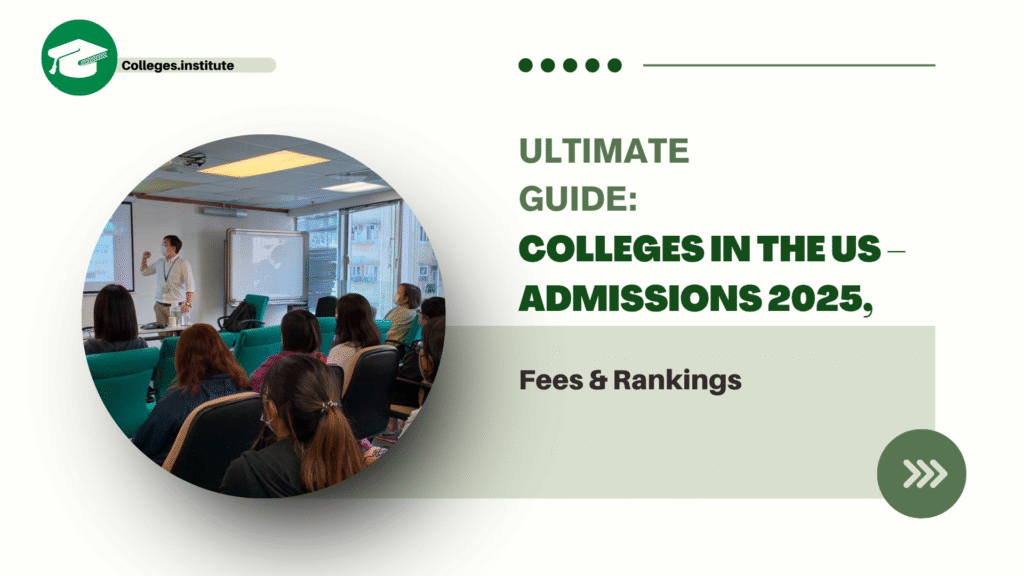
2. College Types & Admission Paths
-
Public Universities (e.g., University of Michigan): lower in-state tuition, merit-based admission
-
Private Universities (e.g., Stanford, MIT): often higher sticker price, strong financial aid options
-
Community Colleges: transferable to four-year degrees
-
Technical & Liberal Arts Colleges: smaller, more intimate learning settings
-
Admission Requirements: High school transcripts, SAT/ACT, TOEFL/IELTS, Letters of Rec., Essays
3. Average Tuition & Total Cost of Attendance
-
Public institutions (2024–25): In-state ~$11,610; Out-of-state ~$30,780
-
Private non-profit colleges: ~$43,350/year; average 13–15% increase from prior year
-
Community colleges: ~$4,818 (in-district) to ~$8,553/year (out-of-district)
-
Living expenses (room, board, supplies): additional $12,600–$15,500 annually
4. Top 10 US Colleges – 2025 Rankings
| Rank | Institution | Avg Tuition & Fees | Avg Net Cost After Aid | Highlights & Apply Link |
|---|---|---|---|---|
| 1 | Harvard University | ~$61,676 | Needs-blind; income < $85K pay $0 en.wikipedia.org | Apply → |
| 2 | MIT | ~$62,396 | Generous aid; top ROI | Apply → |
| 3 | Stanford University | ~$65,910 | Strong financial aid | Apply → |
| 4 | Caltech | ~$65,898 | Leadership in STEM | Apply → |
| 5 | University of Michigan Ann Arbor | ~$14,718 (in-state) / ~$14,718 (private avg) | High ROI in engineering/business | Apply → |
| 6 | Princeton University | ~$62,688 | Full aid for ≤$100K families | Apply → |
| 7 | Yale University | ~$67,250 | Generous scholarships | Apply → |
| 8 | University of California, Los Angeles | $15,203 (in-state) / $49,403 (out-of-state) | Top public univ with global recognition | Apply → |
| 9 | University of Pennsylvania | ~$68,686 | Ivy-level ROI | Apply → |
| 10 | Columbia University | ~$71,845 | Strong urban campus & aid | Apply → |
5. Ivy League & Elite Institutions
-
The eight Ivy League schools hold top global rankings, world-class endowments, and comprehensive financial aid packages
-
Aid policies include full-need and need-blind admissions—for example, Harvard and Princeton cover all costs for families earning < $100K–$150K annually
6. Best Value & High ROI Colleges
-
University of Michigan – Quits top feeder for tech careers, avg salary ~$83K after five years
-
MIT leads ROI rankings per WSJ, with strong early-career salaries in STEM
-
Community colleges offer affordable entry points and seamless transfer pathways
7. Financial Aid & Scholarships
-
FAFSA opens October 1; critical for federal aid, subsidized loans, work-study programs
-
Institutional aid: top schools like Caltech, Yale, Brown, Stanford, Princeton offer full rides for qualifying families
-
529 savings plans are tax-efficient tools for US families to save for education
8. How to Choose the Right College
-
Budget: Compare sticker price vs net cost after aid
-
Major & outcomes: STEM vs liberal arts; research vs service orientation
-
Location & campus life: urban vs suburban, size, culture, diversity
-
Career support: employer connections, alumni network, career fairs
9. Steps to Apply for Fall 2025
-
Research colleges by major, cost, and fit
-
Register and take SAT/ACT, TOEFL/IELTS (if required)
-
Prepare transcripts, recommendations, essays
-
Complete FAFSA (U.S.) or CSS Profile (private schools)
-
Apply via Common App / Coalition App by deadlines (Nov–Feb)
-
Explore DEADLINES (early action Nov, regular Feb–Mar)
-
Respond to acceptance offers and aid packages (May 1)
10. FAQs – Quick Guide
Q. Are US colleges worth the cost?
High ROI, strong career outcomes, especially for STEM/business majors. Private schools promise significant aid reducing actual cost.
Q. Can international students get scholarships?
Yes—select institutions (e.g., MIT, Yale, Princeton) offer generous need-based aid irrespective of nationality.
Q. What is FAFSA and CSS Profile?
FAFSA is government aid form; CSS is used by private colleges for institutional aid eligibility.
Q. Should I attend community college first?
A strategic, cost-effective route to transfer to major universities later.
